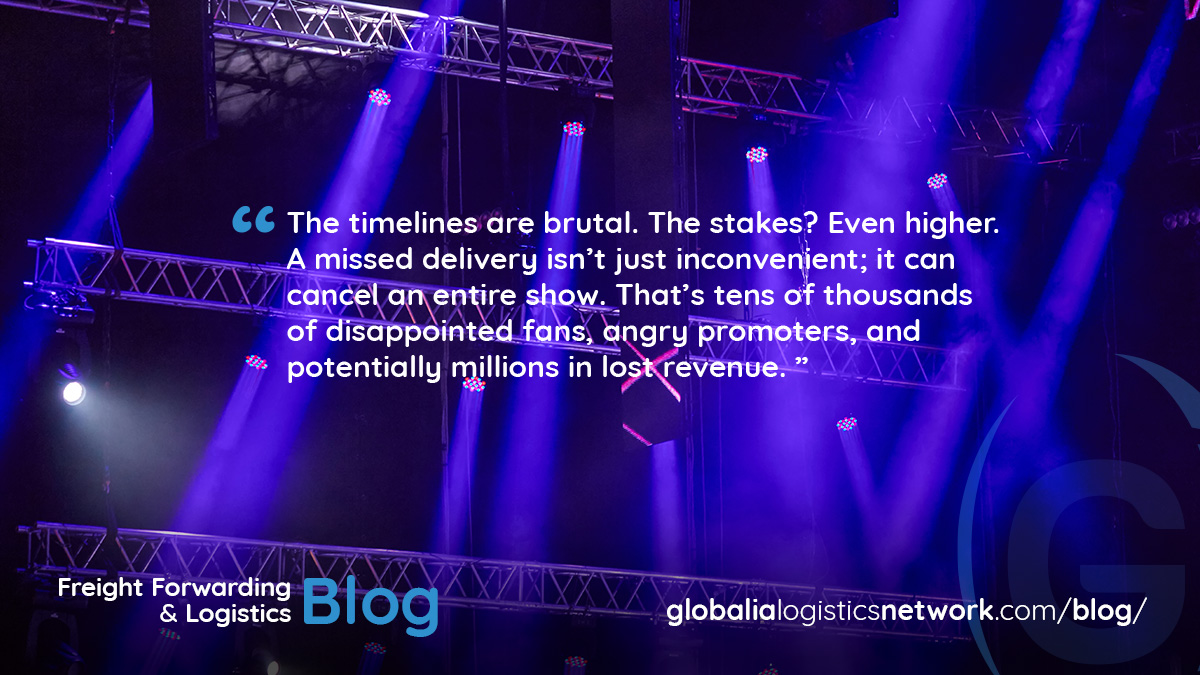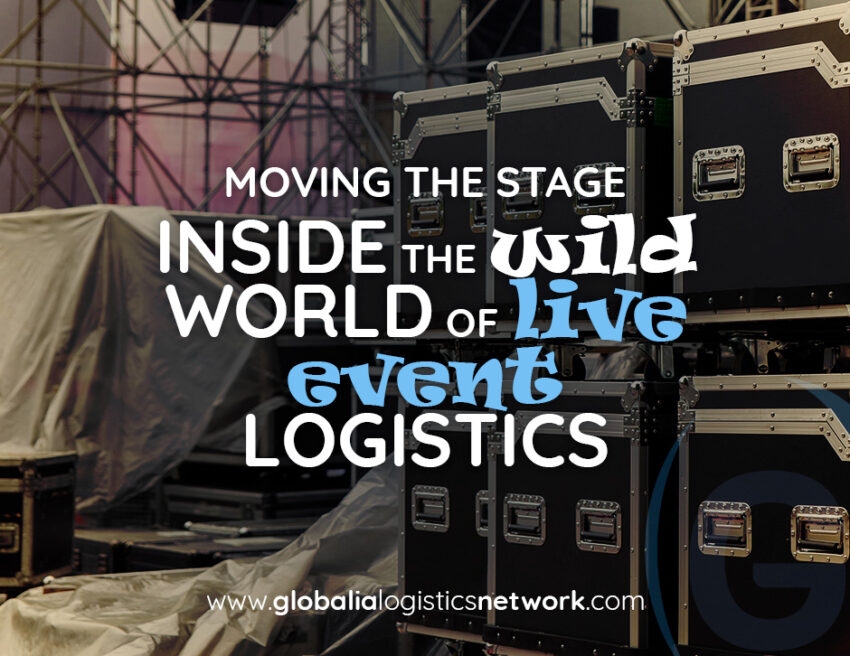Did you catch the Glastonbury Festival this year? Or follow the Gallagher brothers’ reunion tour that set Oasis fans into a frenzy? Think about the spectacle, the lights, the sound, the massive LED walls, and the army of technicians behind it all. Now ask yourself: how does all of that gear move from city to city, country to country, without a single show falling apart? Because here’s the thing: live concerts aren’t just about the performers. They’re powered by a global web of live event logistics so complex and time-sensitive, even seasoned freight forwarders would pause. When the curtain rises, everything has to work- no exceptions, no delays. So what does it take to keep a world tour on track? That’s what we are going to break down in today’s blog.

The scale of a modern concert tour
We’re not talking about a couple of guitars and a mic stand. A large-scale music tour, think U2, Coldplay, Beyoncé, moves with enough equipment to outfit a small factory.
We’re talking:
-
30+ trucks loaded with staging, lighting, audio, and video equipment
-
Multiple customs clearances per week
-
Chartered flights for crew and gear
-
Precision scheduling that syncs load-ins, sound checks, and teardown times in different time zones
And it’s not just the gear. The artists, the road crew, the stage managers, lighting designers, caterers, security—all rely on logistics that work flawlessly across borders.
Live event logistics: Not your average supply chain
If you’re a freight forwarder used to handling pallets of consumer electronics or automotive parts, live event logistics flips the rulebook. The timelines are brutal. The stakes? Even higher. A missed delivery isn’t just inconvenient; it can cancel an entire show. That’s tens of thousands of disappointed fans, angry promoters, and potentially millions in lost revenue. That’s why touring equipment transport requires a blend of speed, precision, and extreme coordination. It’s not uncommon for multiple trucks or flights to move in “leapfrog” fashion, one set of gear arrives at the next venue while the current show is still running.
The freight behind the fame
Let’s break down the moving parts. A typical music tour freight setup might involve:
-
Freight forwarding for entertainment companies, coordinating with local customs agents and port authorities
-
Air cargo charters for delicate or high-priority items like instruments or LED panels
-
Shipping concert gear internationally with ATA Carnets to simplify border crossing
-
Handling fragile equipment that can’t just be tossed on a pallet—think vintage guitars, crystal-clear mic arrays, or custom-built pyrotechnics rigs
All of this falls under one umbrella: live event logistics. It’s a sub-sector of freight that demands 24/7 communication, backup plans for every step, and a deep understanding of both global trade and local conditions.
Customs, carnets, and the clock
No blog on event production logistics would be complete without talking about paperwork. Tour managers rely heavily on ATA Carnets, which act like a “passport” for equipment. They allow goods to move temporarily across borders without paying duties or taxes. But the paperwork still has to be correct, right down to the serial number on a keyboard or the brand of a snare drum. A small customs error can hold an entire truck at the border.
Then there’s customs clearance coordination, often happening in multiple countries on tight schedules. Rejected permits or last-minute regulation changes can throw everything off. Freight forwarders working in this space need serious regulatory foresight and global reach, especially for tours hitting regions like Latin America or Asia-Pacific, where regulations can change quickly and local infrastructure varies widely.
Moving the stage overnight
What happens after the show ends? A highly trained team of roadies and logistics professionals breaks everything down in record time. This is known in the industry as “load-out,” and for big arena shows, it happens overnight. Trucks are loaded in reverse order so that when they arrive at the next city, everything can be set up in the right sequence. Sometimes, there are two full sets of gear leapfrogging across locations—one in transit, one on stage, and another being packed for the next leg. That’s global concert shipping at full throttle.
Tech meets touring
Live event logistics is also getting smarter. GPS tracking, real-time route optimization, and automated customs data systems are increasingly common. These digital tools are especially helpful when moving stage equipment across congested cities or navigating tight time slots at venues. But no matter how advanced the tech gets, human coordination is still at the heart of it. Tour crew coordination, from dispatchers to drivers to customs brokers, remains key.
How freight forwarders can break into this niche
You don’t need to work for a superstar to get involved. Mid-level and regional tours, bands, festivals, corporate events, also require complex logistics solutions.
If you’re a freight forwarder looking to expand your services, start by:
-
Building relationships with event production companies
-
Gaining experience with ATA Carnet processing and temporary import/export handling
-
Offering time-critical and white-glove services for sensitive gear
-
Studying the touring routes of major events in your region to offer proactive help
Live event logistics is demanding, but it pays well and builds long-term, loyal clients who need precision under pressure.
Final soundcheck
Behind every sold-out arena tour, there’s a silent army of logistics professionals making sure the gear shows up, the lights come on, and the bass drops on cue. Live event logistics isn’t glamorous, but it’s thrilling. It combines the best of freight forwarding, problem-solving, and adrenaline-fueled teamwork. And when you pull it off? You may not be in the spotlight, but the show couldn’t happen without you.
So the next time you watch a band take the stage or a DJ light up a stadium, ask yourself: Who got all that gear there, and how did they do it overnight?


